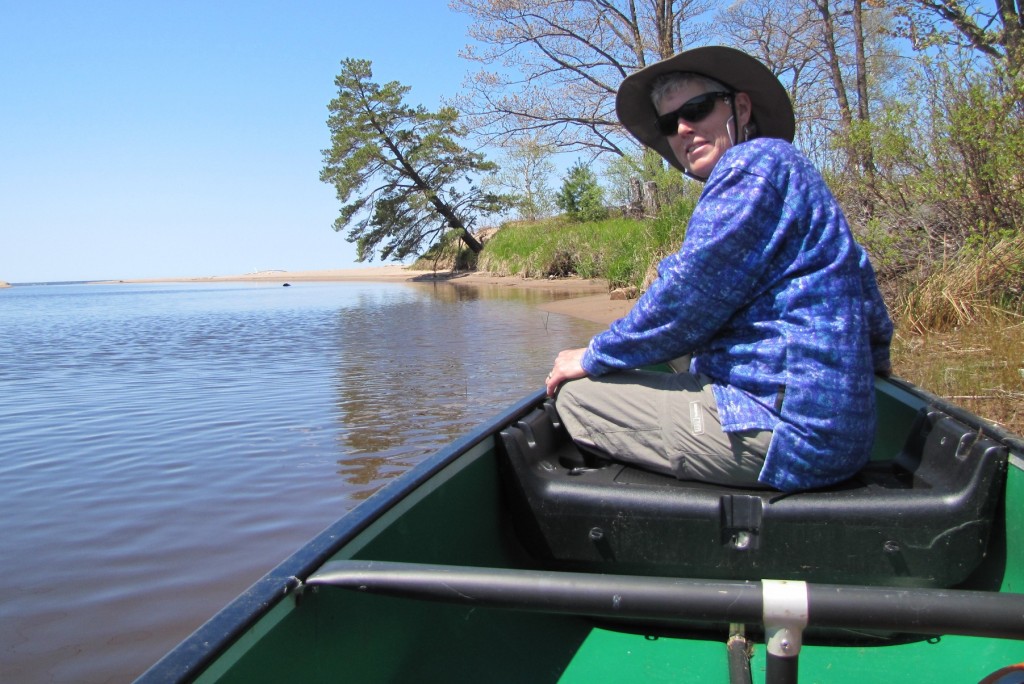This week we are continuing our Full Length Mississippi series with Mike Link and his wife Kate Crowley. Mike is the retired founding director of The Audubon Center of the North Woods in Minnesota, an author of 24 books, a published researcher (vernal ponds and ornithology), a college instructor at Hamline University, and a consultant to non-profits.
When we decided that our effort to understand fresh water systems would move from Lake Superior to the Mississippi River it meant more than the change from a lentic system – still waters (as lakes or ponds) to a lotic system – actively moving water. It also became a matter of defining the cultural system that is part of the river.

Kate Crowley sits in a boat on Lake Superior, which shows how calm the waters are. Photo Courtesy of Mike Link.
On Lake Superior two countries shared the large lake, Canada and the United States, with one province in Canada and three states in the US. The states were at similar latitudes since the lake’s largest measurement is east/west. The people who live along the lake have adapted to similar climate and forest types and therefore have similar lifestyles. They also have very similar immigration patterns with predominately northern European ethnic backgrounds. These individuals came for logging, trapping, and mining opportunities, so they were recruited from countries where those skills were common. The American Indian population was predominately Algonquin – Cree First Nation in Canada, Ojibwe in the US, with a few Dakota (Sioux bands) remaining from the time before they were displaced by wars with the Ojibwe/Cree.
As we discussed in our first post, The Mississippi River has a watershed of 31 states and two Canadian Provinces. Canada does not border the river, but it has a few tributaries that feed into the overall system. Therefore, the political divisions of the river are all part of the US. Out of these 31 states, 10 actually border the Mississippi.
The river begins in the area of Northern Boreal Forest, but very near the Great Plains and flows south forming a natural boundary between the Eastern and Western United States. Its primary tributaries are the Missouri River, which reaches to the mountains and can be said to be part of the Great Plains and American West, and the Ohio River, which runs from Pennsylvania in the east through the Midwestern states of Ohio, Indiana, and Illinois. Historically the Ohio separated the North and the South as much as the famous Mason-Dixon Line – a much more arbitrary boundary.
Since the river runs from the lands of the black spruce and moose to the cypress and the alligator, it is obvious that we would find a lot of change. Instead of following latitude, the Mississippi follows longitude and the climate shifts drastically from the Gulf of Mexico to the Canadian border. We took a trip south by car as a preliminary investigation of the river to discover bike routes and make notes of the variations that stood out to two northerners!
Suggested activity: Think about how the Mississippi River would change with latitude as you traveled along its distance from north to south. How could this inspire a local research project? With the Phenology and Climate Intensive Observing Period occurring, think of the connection of latitude to phenological events such as Budburst, Green Up and Green Down. Use GLOBE Student collected data to motivate your research further, and be sure to tell us about it either through a comment, our website, or our Facebook page.

I like the magnificent and spectacular Mississippi River.
Thank you for taking the time to remind us that even scientists are human, and that doing science isn’t so easy! We are just glad you are Okay